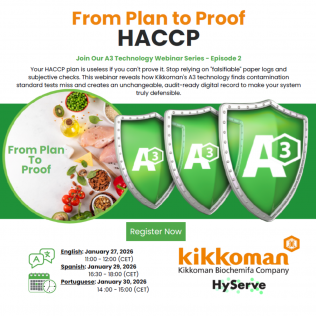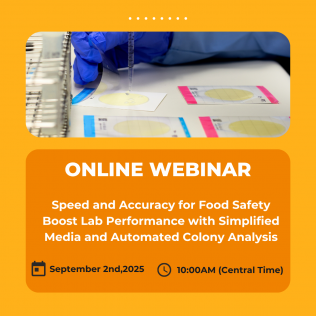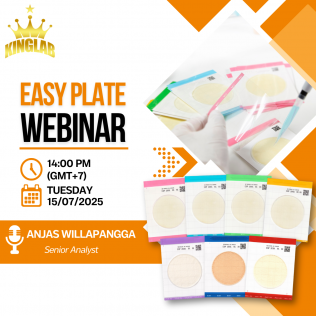_png_w316px_h237px.png)
Outline
| Product | ATP Test (Kikkoman A3): LuciPac A3 Surface, LuciPac A3 Water, LuciPac A3 Pre-moisten,Easy Plate, |
|---|---|
| Event date | 2024.06.20 |
Seminar Detail
| Venue | Webinar |
|---|
Result contents
Objective
In today's dynamic food and beverage industry, maintaining impeccable hygiene standards is paramount to ensuring consumer safety and product reliability. To address these crucial aspects, " Enhancing Hygiene Control in Food and Beverage with ATP Test (Kikkoman A3) and Ready-to-Use Medium Easy Plate” is designed to provide actionable insights and practical tools for optimizing hygiene management practices.
The seminar will kick off with an in-depth exploration of the fundamental importance of hygiene control in food and beverage industry. Participants will gain a comprehensive understanding of the potential risks associated with inadequate hygiene measures and the impact on consumer trust and brand reputation.
A key highlight of the seminar will be the examination of ATP Test (Kikkoman A3) as a cutting-edge solution for rapid and reliable hygiene monitoring. Attendees will discover how this innovative testing method can revolutionize their hygiene control protocols, enabling them to detect and address potential issues swiftly, thereby safeguarding product quality and consumer well-being.
Furthermore, the seminar will showcase the transformative capabilities of ready-to-use medium Easy Plate for microbiological testing processes. Attendees will learn about the unique features of Easy Plate, including its stackable film plate format, space-saving design, and AI-powered Colony Counting System. This system not only enhances accuracy and efficiency in colony analysis but also simplifies result interpretation and documentation.
Throughout the seminar, attendees will have the opportunity to engage in interactive discussions, share best practices, and collaborate with industry experts to develop tailored strategies for implementing ATP testing and Easy Plate in their respective operations. Practical demonstrations and case studies will further illustrate the real-world benefits of these hygiene control solutions.
Overview
This seminar aims to explore the pivotal role of ATP testing and Easy Plate kits in upholding hygiene control and safety standards within the food and beverage industry. Attendees will gain valuable insights into the advantages offered by these innovative tools, including their speed, user-friendliness, cost-effectiveness, and precision in monitoring hygiene levels across production processes.
Seminar Objectives
- Develop a comprehensive understanding of the significance of hygiene management in the food and beverage industry.
- Investigate the benefits of utilizing ATP Test (Kikkoman A3) for swift and dependable hygiene monitoring.
- Discover how Easy Plate can optimize time, minimize labor costs, and enhance product quality in food and beverage manufacturing.
What Attendees will learn
- Gain in-depth knowledge of cutting-edge hygiene monitoring techniques.
- Learn how to improve efficiency, reduce costs, and enhance product quality in food and beverage industry.
- Receive practical tips and resources for implementing ATP testing and Easy Plate
- Understand the Colony Counting System for Easy Plate, featuring highly accurate analysis powered by AI technologies.
Objective
In today's dynamic food and beverage industry, maintaining impeccable hygiene standards is paramount to ensuring consumer safety and product reliability. To address these crucial aspects, " Enhancing Hygiene Control in Food and Beverage with ATP Test (Kikkoman A3) and Ready-to-Use Medium Easy Plate” is designed to provide actionable insights and practical tools for optimizing hygiene management practices.
The seminar will kick off with an in-depth exploration of the fundamental importance of hygiene control in food and beverage industry. Participants will gain a comprehensive understanding of the potential risks associated with inadequate hygiene measures and the impact on consumer trust and brand reputation.
A key highlight of the seminar will be the examination of ATP Test (Kikkoman A3) as a cutting-edge solution for rapid and reliable hygiene monitoring. Attendees will discover how this innovative testing method can revolutionize their hygiene control protocols, enabling them to detect and address potential issues swiftly, thereby safeguarding product quality and consumer well-being.
Furthermore, the seminar will showcase the transformative capabilities of ready-to-use medium Easy Plate for microbiological testing processes. Attendees will learn about the unique features of Easy Plate, including its stackable film plate format, space-saving design, and AI-powered Colony Counting System. This system not only enhances accuracy and efficiency in colony analysis but also simplifies result interpretation and documentation.
Throughout the seminar, attendees will have the opportunity to engage in interactive discussions, share best practices, and collaborate with industry experts to develop tailored strategies for implementing ATP testing and Easy Plate in their respective operations. Practical demonstrations and case studies will further illustrate the real-world benefits of these hygiene control solutions.
Overview
This seminar aims to explore the pivotal role of ATP testing and Easy Plate kits in upholding hygiene control and safety standards within the food and beverage industry. Attendees will gain valuable insights into the advantages offered by these innovative tools, including their speed, user-friendliness, cost-effectiveness, and precision in monitoring hygiene levels across production processes.
Seminar Objectives
- Develop a comprehensive understanding of the significance of hygiene management in the food and beverage industry.
- Investigate the benefits of utilizing ATP Test (Kikkoman A3) for swift and dependable hygiene monitoring.
- Discover how Easy Plate can optimize time, minimize labor costs, and enhance product quality in food and beverage manufacturing.
What Attendees will learn
- Gain in-depth knowledge of cutting-edge hygiene monitoring techniques.
- Learn how to improve efficiency, reduce costs, and enhance product quality in food and beverage industry.
- Receive practical tips and resources for implementing ATP testing and Easy Plate
- Understand the Colony Counting System for Easy Plate, featuring highly accurate analysis powered by AI technologies.
Related seminars
-

Event Overview
HyServe will be hosting an upcoming webinar as part of the A3 Webinar Series.
Dates and Times (CET):
- English Session: Jan 27, 2026 | 11:00-12:00
- Spanish Session: January 29, 2026 | 16:30 – 18:00
- Portuguese Session: January 30, 2026 | 14:00 – 15:00
Are you confident your HACCP plan can move from a binder on a shelf to verifiable, audit-ready proof in seconds?
Managing food safety with manual logs and subjective visual checks is time-consuming, prone to errors, and difficult to defend during an audit. When a deviation occurs, how quickly can you "close the loop" to prove your corrective action was effective? Join our upcoming webinar to learn how to automate and strengthen your entire food safety program. We will explore how Kikkoman's A3 technology and the Lumitester App directly support the most critical "action" principles of HACCP—Monitoring, Corrective Actions, and Verification.
What You Will Learn
In this webinar, we will cover:
- Why Superior Sensitivity Matters: How Kikkoman's A3 technology (measuring ATP+ADP+AMP) finds contamination from processed or heated foods that standard ATP-only tests miss.
- Automate Monitoring (Principle 5): Move from subjective "visual checks" to objective, numerical RLU data for a consistent standard of "clean".
- "Close the Loop" on Corrective Actions (Principle 6): Use real-time results to trigger an immediate corrective action (re-clean) and instantly re-test to verify it was successful.
- Achieve Total Accountability (Principle 7): Eliminate "messy, error-prone, and falsifiable" paper logs. See how every test is automatically saved to the cloud with the operator ID, time, date, and location, creating an unchangeable, audit-ready digital record.
- Verify Your System: Use the app's data to instantly identify sanitation trends, validate cleaning procedures, and prove your HACCP plan is working effectively.
Target Audience
- Quality Assurance Managers
- HACCP Coordinators
- Food Safety Professionals
looking to save time, reduce risk, and create a truly defensible food safety system.
Speaker Information
- Jorge E. Padilla
- Stella Maciel
-

- Event date
- 2025.09.03
- Product
- Easy Plate (AC, EC, CC, SA, YM-R,EB,AC-R)
- Venue
- Webinar
-

- Event date
- 2025.07.15
- Product
- Easy Plate (AC, EC, CC, SA, YM-R,EB,AC-R)
- Venue
- Webinar

